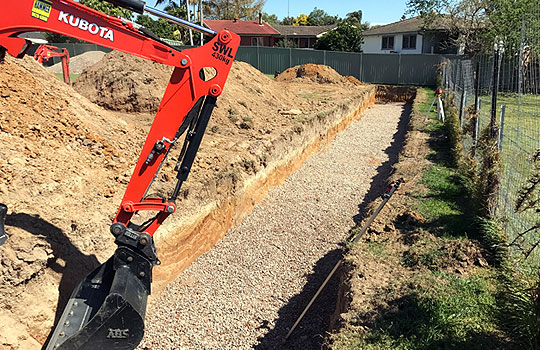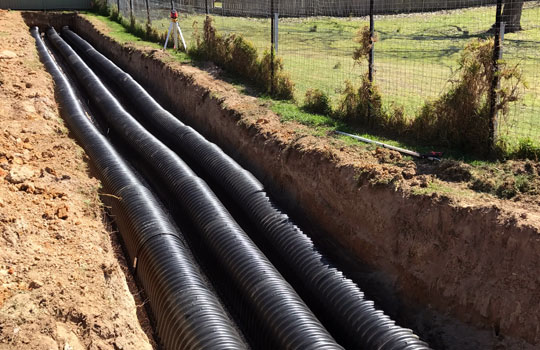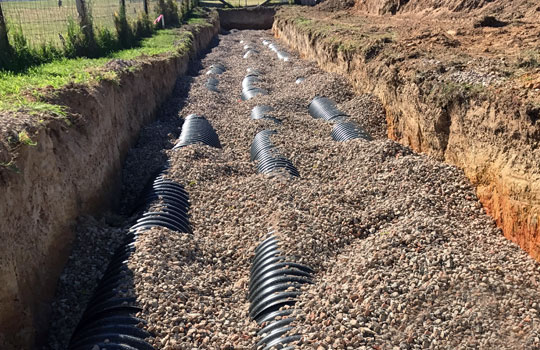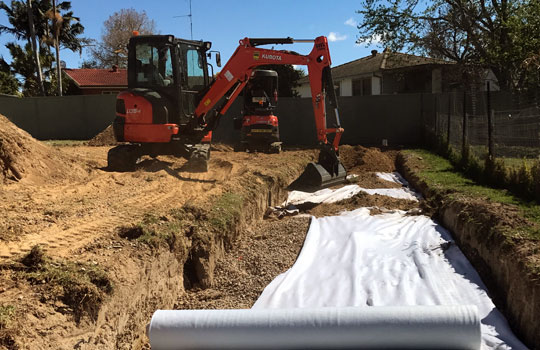An On-site Sewage Management System refers to any system that processes sewage and disposes of the effluent by applying it to the land within the property boundary.
If your home is not connected to the sewer, you may need to have an On-site Sewage Management System.
Septic tanks and trench style absorption systems are the most common type of domestic wastewater treatment systems in Australia.
There are special regulations that apply to these On-site Wastewater Management Systems and as the owner of the property, it is your responsibility to ensure that the system is approved by your local council and is working efficiently and safely.
What is a Sewage Absorption Trench?
Absorption trenches are usually built below ground and the bottom layer is filled with a hard aggregate such as uncompacted gravel. Either perforated piping, self-supporting arch trenching or box trenching is placed in the trench and is backfilled with gravel. A geotextile filter cloth is then laid over the pipe and gravel and under the top soil to ensure that the soil does not penetrate and block the trench.




Effluent flows into the trenches where it is absorbed through the trenching material and into the surrounding soil. The absorption process and the action of bacteria in the soil treat the effluent.
If you are building a new home that requires an On-site Wastewater Management System or have an existing system that needs to be altered, All Line Plumbing are here to help!
If your local council require you to have an On-Site Wastewater Management System on your new or existing property, contact us today. We can point you in the right direction to start the process of assesment, system design and approval and get your On-site Wastewater Management System installed.
Contact Us TodayHow does an On-site Sewage Management System work?
Your septic system treats your household wastewater by temporarily storing it in the septic tank where bacteria do the work of digesting waste. Fats and solids are retained in the tank and liquid effluent flows into the trench and is further treated by the soil.
The contents of a healthy septic tank should form 3 layers:
- A layer of fats (called scum) which floats to the surface.
- A clear layer (called effluent).
- A layer of solids (called sludge or bio-solids) which sinks to the bottom.
When the tank gets too full, wastewater is gravity-fed or pumped from the septic tank/s into an absorption trench. Eventually the water evaporates from the soil, is absorbed or is taken up by plants growing on the absorption area.
On-Site Sewage Management System Problems
Clogged trenches are a common cause of septic system problems. Trenches fail when they get blocked and effluent is unable to evaporate or drain away.
You can tell if the trench has failed because the area will be soggy, smelly and covered with dense grass.
Other signs for On-site Sewage Management System issues include:
- Odours outside the house.
- Toilet does not flush easily and quickly.
- Water goes slowly down drains.
- Gurgling sounds in the plumbing.
- Backup of sewage in house plumbing.
- Tank has not been pumped out in the past 5 years or checked in the past 2 years.
- Rampant weed growth downhill of the absorption trench.
Should you notice any of the above signs, contact All Line Plumbing immediately.
Badly maintained On-site Sewage Management Systems can:
- Cause a serious health threat to family and neighbours.
- Degrade the environment, especially waterways.
- Reduce the value of your property.
- Be very expensive to repair.
If you have absorption trenches don't wait until the trench starts to fail before having your tank pumped.
The NSW Government introduced the SepticSafe Program in 1998 to help property owners and Councils keep onsite sewage management systems working efficiently and safely. All owners of onsite sewage management systems are now required to apply to Council for an Approval to Operate (license).

